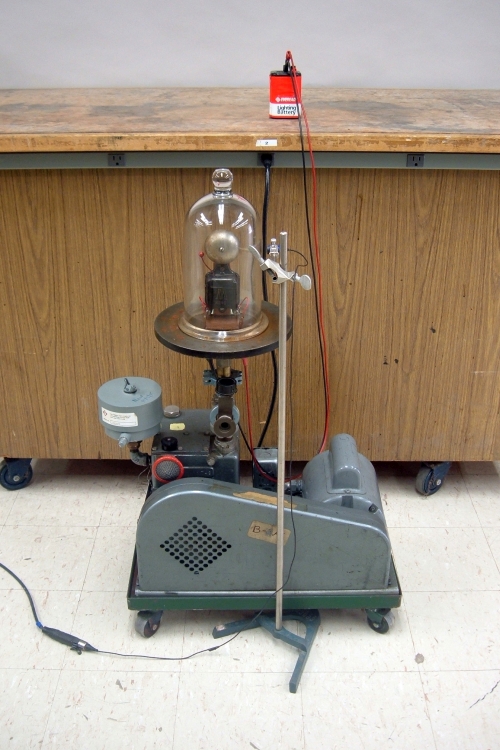
Turn on the bell by moving the stacked banana plug to the unconnected battery terminal. A microphone set near the bell jar picks up the sound of the bell so that the class can hear it through the sound system of the lecture hall. Now turn on the vacuum pump. The sound from the bell quickly diminishes until you and the class can no longer hear it. Now turn the pump off, and slightly open the vent valve underneath the vacuum plate. As air begins to fill the bell jar, you and the class begin to hear the sound of the bell, which grows louder until the bell jar is once again filled with air.
This demonstration is a classic, and the phenomenon that it illustrates is the basis for one of the tag lines of the 1979 film “Alien” – “In space no one can hear you scream.” Sound is a longitudinal wave, that is, one in which the disturbance that produces the wave, is in the same direction as that in which the wave itself propagates. It is also a mechanical wave; it requires a medium in which to propagate. The medium can be a solid, liquid or gas. Sound is a series of alternating compressions, regions of relatively high pressure, and rarefactions, regions of relatively low pressure, in a medium, produced by the motion of some vibrating body, for example, the bell in this demonstration. When the clapper strikes the bell, it sets the bell oscillating. As the bell oscillates, it disturbs the air around it, thus creating a pattern of periodic compressions and rarefactions – a sound wave. When this sound wave reaches our ears, we hear the bell ringing. Of course, since the bell is ringing inside a bell jar, the air in which it produces the sound wave is confined by the bell jar. The sound wave, however, causes the bell jar to vibrate, and the bell jar, in turn, causes the air around it to vibrate.
As described above, to set the bell ringing, take the banana plug that is inserted into the other banana plug (stacked), and move it to the unconnected battery terminal. You and the class now hear the bell ringing.
When you turn on the vacuum pump, the pump begins to evacuate the bell jar. As the pressure inside the bell jar drops, there is less and less air to carry the sound wave, and the ringing of the bell becomes softer and softer, until there is so little air in the bell jar that the sound wave has no medium in which to propagate, and you and the class cannot hear the ringing of the bell. (Rubber cushions underneath the stand that holds the bell, isolate the bell from the vacuum plate, so that the sound from the bell is not transmitted through the stand to the vacuum plate.)
Once you have evacuated the bell jar, if you wish to show that the bell really is inaudible, and that its sound is not merely being masked by the noise of the pump, it is all right to turn the pump off and leave it for a short time, but do not leave it off and under vacuum for too long. Once you have shown the students that they really cannot hear the bell, slightly open the vent valve beneath the vacuum plate, and allow air slowly to enter the bell jar. You and the class again can hear the ringing of the bell.